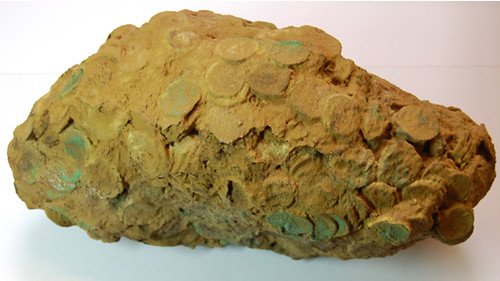
PREV ARTICLE
NEXT ARTICLE
FULL ISSUE
PREV FULL ISSUE
CONSERVATION OF THE BEAU STREET COIN HOARDArthur Shippee forwarded this article from the
British Museum about conservation of the Beau Street Hoard.
Thanks! -Editor
For those who have been following the progress of the conservation of the Beau Street Hoard on the blog, I am delighted to announce that all the coins – around 17,500 of them – have now been cleaned to required identification standards, that is, to the point where the legend and significant features are readable. Conservator Julia Tubman carried out the bulk of this work on the c.17,500 coins contained within the hoard. Additional work has been carried out on a small number of these coins and conservation has also been carried out on c.400 coins that were initial finds from the outer edges of the hoard, before the hoard proper was unearthed. This last group of coins were in particularly poor condition and most required substantial chemical and manual cleaning. These coins were held in numbered paper envelopes, some of which corresponded to small find numbers allocated when the hoard was excavated. The soil block that held the hoard has now been dismantled and returned to the archaeologists who carried out the initial excavation for final sifting and checking for palaeoenvironmental remains: that is, material that might provide further contextual information about the coin hoard. At the time of Julia’s last post, she reported that one of the coin clusters (bag 4), had been scanned. As with the other coins in the hoard, the clustered corroded coins retained the positions that they would have held in the bag in which they had been deposited. In this instance the bag shape was particularly well preserved. The initial scan was carried out at the British Museum by Martin Cooper of the Conservation Technologies Unit, National Museums Liverpool (NML). The scan data was used to create a 3D computer model, which was then 3D printed to make a replica of the coin bag using Selective Laser Sintering (SLS), a process that uses a laser to fuse particles of plastic or other material into the required three-dimensional form. A plaster cast was then made from the print and this was painted to resemble the original coin cluster, by conservators at NML. 
Beau Street hoard replica The replica has proved very popular among visitors to the Roman Baths and was shown at a Beau Street Hoard community consultation event run by staff at the Roman Baths earlier in 2013. Members of Bath Ethnic Minority Senior Citizens Association (BEMSCA) were among those who handled the replica. As a three-dimensional record of the original form of the coin bag, which of course no longer exists now that the coins have been conserved, the replica is an excellent supplement to the information gathered about the hoard, an invaluable means of allowing people to gain some sense of the physicality of (at least part) of the hoard. Great job on the replica - nice idea!
-Editor
To read the complete article, see: The Beau Street Hoard: Not quite the end… conservation, outreach and further investigations (blog.britishmuseum.org/2014/04/08/the-beau-street-hoard-not-quite-the-end-conservation-outreach-and-further-investigations/) Wayne Homren, Editor The Numismatic Bibliomania Society is a non-profit organization promoting numismatic literature. See our web site at coinbooks.org. To submit items for publication in The E-Sylum, write to the Editor at this address: whomren@gmail.com To subscribe go to: https://my.binhost.com/lists/listinfo/esylum All Rights Reserved. NBS Home Page Contact the NBS webmaster 
|